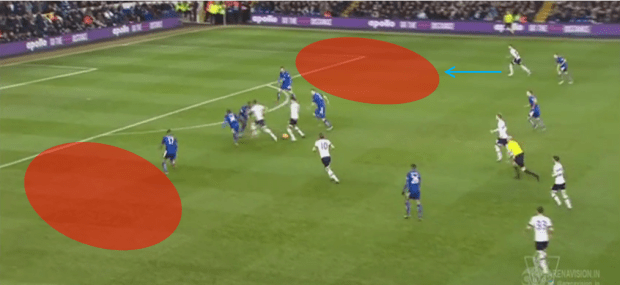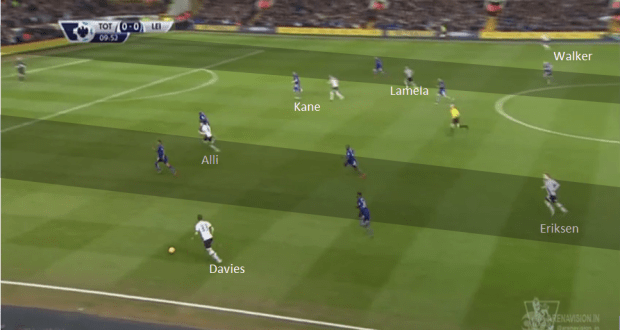By
Luke Balls-Burgess on January 17, 2016
@LukeBBurgess
A top of the table six-pointer took place at White Hart Lane between top four hopefuls Spurs and Leicester only a matter of days after the two sides had played each other in the same fixture in the FA Cup. The two most difficult sides to beat this season in the Premier League clashed in what nearly the whole footballing world knew would be a tight affair, one that was unlikely to be decided by more than a goal or two.
Eriksen’s new role in Spurs’ 1-4-3-2-1
Issues in possession of the ball at the start of the season haunted Spurs, preventing them from turning many of those early draws into vital wins. Two of the main issues occurred after Spurs broke the opposition’s first line of pressure, slow circulation of the ball between midfield and the fullbacks often allowed the opposition to recover a solid defensive shape. This resulted in Spurs’ playmakers receiving the ball in congested areas with limited passing options, thus preventing Spurs from penetrating opposition defences from central areas with any regularity. A by-product of all this was that Harry Kane was often forced to drift deeper in search of the ball, often making life easier for the opposition defence.
Over the Christmas period, Pochettino made various slight tactical tweaks to his favoured 1-4-2-3-1 formation, usually revolving around the positioning of Cristian Eriksen and the advanced midfield ‘3’. Memories of the 4-1 thrashing of West Ham illustrated Eriksen’s deeper movement, seeing him drop deep into the left half-space in order to enjoy easier access to the ball with more time and more space. Developing on from this, against Leicester, Eriksen would drop very deep centrally, alongside Spurs double pivot of Tom Carroll and Eric Dier, thus prompting the change to a 1-4-3-2-1 shape for Spurs with Alli and Lamela in close support behind Kane up top.
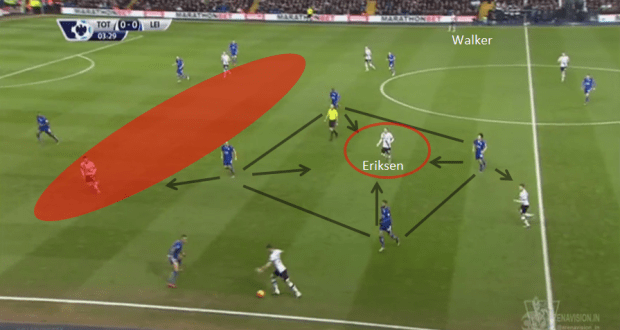
Above we can see how Eriksen’s deeper positioning impacted Leicester’s defensive shape. Eriksen has often shown a great deal of positional intelligence when he plays, often positioning himself in provocative situations in between three or four opposition players. In this instance, Eriksen’s position is occupying four Leicester City players and because of how deep he is whilst occupying Leicester’s central midfield (Drinkwater and Kante) this opens up a large amount of space in between Leicester’s defensive and midfield lines. This often created passing opportunities into the feet of Spurs’ attackers (Alli, Lamela and Kane). This also removes some of the playmaking responsibility from the likes of Carroll and Dier, both inexperienced players who benefit from having an easier route into Eriksen’s feet (especially considering Dier’s technical inefficiencies).
The above image also illustrates Leicester’s narrow defensive shape, opening up a great deal of space for Walker on the right flank which could potentially have been exploited.
Elements of Juego de Posicion in Spurs play
Spurs have shown under Mauricio Pochettino how well they can regularly by-pass the opposition’s first line of defensive pressure by conditioning their opponents into a more open 1-4-4-2 defensive shape thanks to the movement of their fullbacks and midfield pivot. Known as ‘La Salida Lavolpiana’, Spurs often used either one of Dier or Carroll to drop in between or outside the centre back partnership of Vertonghen and Alderweireld in order to outnumber the Leicester front line of Vardy and Okazaki in order to circulate the ball past the Leicester frontline with more ease. The movement of Carroll and Dier opened up space in the centre for Eriksen to drop into and enjoy his new deeper role. This also allowed Spurs’ fullbacks to enjoy a greater influence on the game, although it was clear looking at Leicester’s defensive shape that they encouraged Spurs to pass wide rather than through the centre.
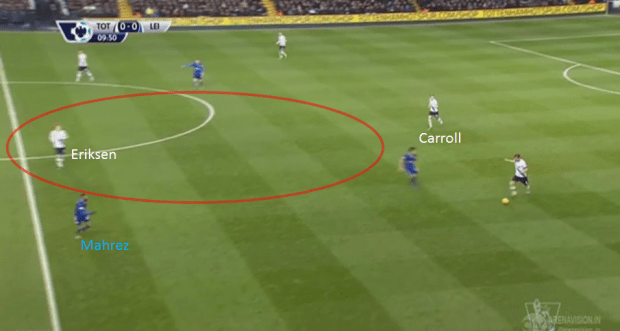
The above image illustrates how Carroll has moved deeper, in between Alderweireld and Vertonghen in order to outnumber Vardy and Okazaki two vs one, creating space in the centre for Eriksen. This also illustrates Leicester’s defensive shape/issues as Mahrez steps too far inside allowing Vertonghen to feed Davies far up the pitch.
Another development in Spurs’ play when entering the oppositions final third has seen a concentrated effort from the team to occupy the five vertical channels of the pitch in order to stretch and pin back the oppositions defensive shape. Dier’s disciplined role has rarely seen him advance up the pitch with the rest of the midfield as Spurs enter the oppositions final third, this allows Davies and Walker to occupy the two flanks higher up the pitch offering a potential wider route into the space behind Leicester’s defensive line.
Due to Mahrez and Albrighton stepping infield in order to maintain a very narrow and horizontally compact shape for Leicester, if Spurs were capable of by-passing the Leicester midfield line quick enough (like they did in the image above) this left huge gaps outside Leicester’s fullbacks which could’ve been exploited had Spurs recognised these opportunities.
Pinning Leicester’s backline back in this way also created space higher up the pitch for Eriksen who was now joining attacks later on due to his deeper starting position. This allowed Eriksen to offer himself as a cutback option in order to create a shooting opportunity on goal or as a pivot in order to quickly transition the ball from one flank to another higher up the pitch. Eriksen found it easier to find space higher up the pitch from this deeper starting position as he was now behind the play during such moves, meaning as Leicester’s midfield line made their recovery runs they wouldn’t be looking at Eriksen as he would now be behind them, allowing him to make blindside movements and free himself of any specific man-markers.
As we can see, Mahrez and Kante are forced to turn their backs on Eriksen as they make their recovery runs, thanks to Leicester’s narrow defensive shape opening up space down their flanks.
Spurs 1-4-3-2-1 can also be highlighted by looking at Spurs’ passing map, showing how regularly Spurs’ central midfielder’s and fullbacks accessed the ball also illuminating on Lamela’s and Alli’s aggressive roles.
Leicester’s Offense
Against such a possession hungry Spurs, Leicester showed throughout the game they were happy to try and absorb the Spurs pressure whilst protecting the vital central areas of the pitch. With the likes of Vardy, Albrighton, Mahrez and Kante offering blistering pace on the counter attack, Leicester allowed Spurs a way up the pitch which (in theory) wouldn’t threaten their goal too much if they were able to limit Spurs to crossing the ball. This would create large amounts of space behind Spurs’ defensive line to be exposed by Leicester’s pace, forcing the Spurs defensive line into defending whilst on the recovery run and whilst facing their own goal.
Like with Eriksen, this would mean Spurs’ defensive line would struggle to cope with dealing with late Leicester attackers as if the initial Leicester counter wasn’t successful, then the likes of Mahrez, Drinkwater and Kante would arrive late in the Spurs final third attacking an unorganised and panicked defence.
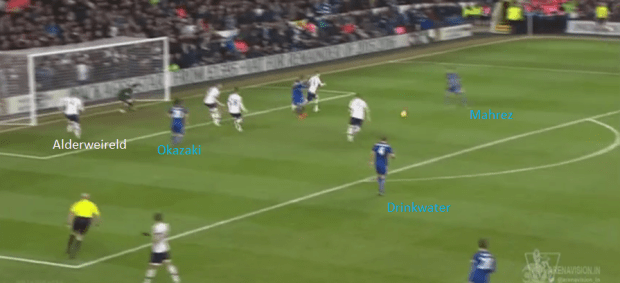
Ulloa’s introduction merely enabled Leicester a faster route up the pitch offering himself for flick-ons to Leicester’s runners as well as enabling Leicester to disrupt Spurs defensive shape whilst competing over the second balls. Leicester’s high tempo and direct style of offence often created situations such as the one above in the 76th minute of the game. As the Spurs defensive shape has been disrupted by Albrighton’s run and cross to the by-line, the Spurs defence is now unorganised and many of Leicester’s attackers are unaccounted for and left with time and space inside Spurs’ penalty area. Mahrez’s run at the back post has not been tracked as he prepares to shoot, Drinkwater has time and space on the edge of the penalty area and nearly every Spurs defender has their back to Okazaki who has space six yards out from Spurs’ goal. The panic created by Leicester’s offence has caused this and creates situations like above where Alderweireld’s first instinct is to get on the goal line where he’ll keep every Leicester attacker onside and leave Okazaki unmarked. This lack of composure was matched however by Leicester’s offense who didn’t show off their technical qualities by finishing any of these chances which kept Spurs hopeful of another late and dramatic winner (a la Watford and nearly all of their 2014/15 season).



